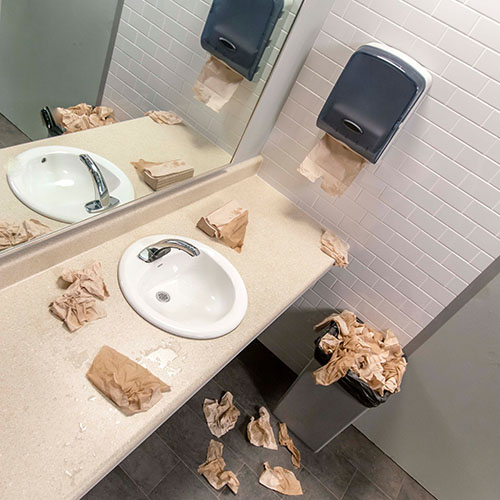NEWS AND KNOWLEDGE
The Forgotten Restaurant Restroom that Patrons Won’t Forgive
This article first appeared in Restaurant Business Daily, a Winsight publication.
By now, the correlation between dirty restrooms and unhappy guests is well-established: Countless surveys have shown that restaurants are especially at risk of losing customers if they don’t stay on top of their guest facilities. Yet messy, unclean, poorly supplied restrooms remain an issue, especially at very busy operations.
“People say they evaluate a restaurant based in part on the restroom, because if they’re not taking care of that, then what does the kitchen look like? It’s clearly an extension of the brand,” says Bob Berry, towel category director at Georgia-Pacific (GP PRO).
Berry offers some suggestions for making sure the facilities leave a favorable impression.
Take care of the basics. A good place to start is by trying to see the restroom through the eyes of a customer and considering how to improve the overall experience. Employees use the facilities—ask for their input about what can be improved. Are the toilets, sinks and dispensers in good working order? If not, fix them.
Next, consider what the average person wants from a public restroom. “People don’t want to see, smell or hear others,” Berry says. “They also don’t want to touch places that others may have touched. Those are good places to focus.”
Create a plan of attack. The best strategy involves a multipronged approach of consistent routine, vigilance and automation.
An effective routine means assigning employees to make sure the facilities are tidy and well stocked during down times, to be ready for the rush. Because each operation has its own level of traffic, there is no set rule for when or how often, but the specifics should be part of a job description. And posting a monitoring schedule in the restroom that gets initialed throughout the day provides patrons some peace of mind.
Vigilance is everyone’s job. Any employee or manager who notices something amiss needs to report it so it can be handled, especially if it occurs during meal times. Technology can help—to a point. “We are doing some work at Atlanta Hartsfield Airport with smart towel and tissue dispensers, which monitor the supply levels and alert managers or employees when they are low,” Berry says. “Interestingly, the airport has found that a better restroom experience results in guests spending more money.”
Automation can also alleviate a number of pain points in restrooms. Automated freshener dispensers in individual stalls can keep a lid on odors. They work by attaching an air fresher on top of the tissue dispenser which mists a pleasant fragrance based on motion from the stall door or an individual’s hand wave. Stacks of paper towels, which topple or get wet from previous users, can be replaced by high-capacity touchless dispensers. These units satisfy germ-averse patrons, help control paper waste and reduce the chance of outages.
In the end, a restroom is an often-overlooked element of a restaurant’s brand equation. The food might be terrific, the décor stunning and the service stellar. But a spotless, well-functioning bathroom is sure to score with guests as well.
Back to All News and Knowledge

